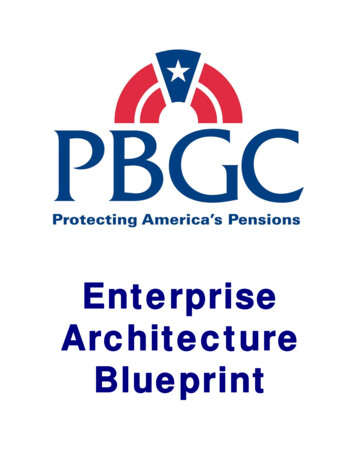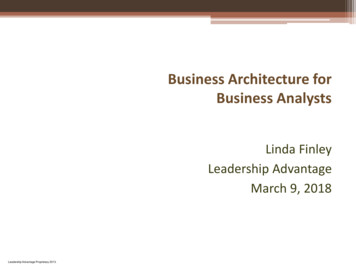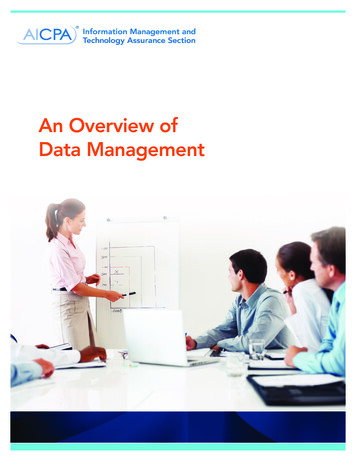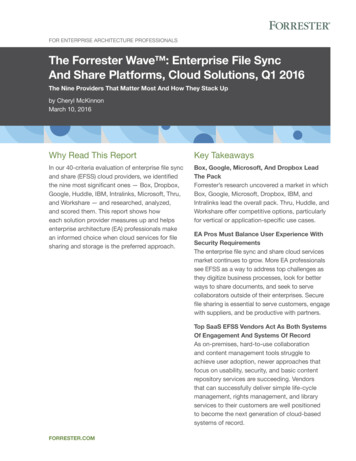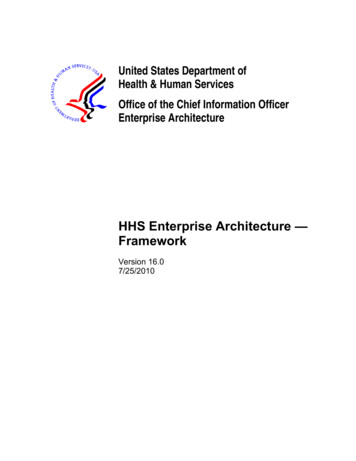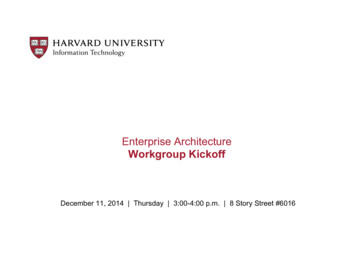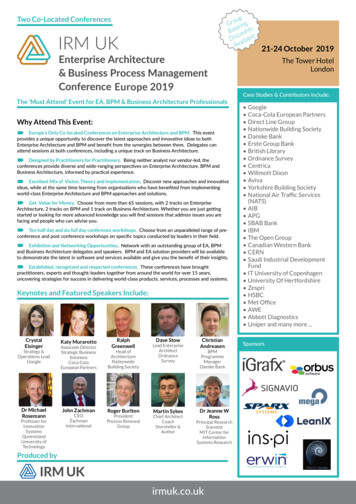
Transcription
oupGr kingoBo ountscDis ilableAvaTwo Co-Located Conferences21-24 October 2019The Tower HotelLondonEurope 2019The ‘Must Attend’ Event for EA, BPM & Business Architecture ProfessionalsWhy Attend This Event: Europe’s Only Co-located Conferences on Enterprise Architecture and BPM. This eventprovides a unique opportunity to discover the latest approaches and innovative ideas to bothEnterprise Architecture and BPM and benefit from the synergies between them. Delegates canattend sessions at both conferences, including a unique track on Business Architecture. Designed by Practitioners for Practitioners. Being neither analyst nor vendor-led, theconferences provide diverse and wide-ranging perspectives on Enterprise Architecture, BPM andBusiness Architecture, informed by practical experience. Excellent Mix of Vision, Theory and Implementation. Discover new approaches and innovativeideas, while at the same time learning from organisations who have benefited from implementingworld-class Enterprise Architecture and BPM approaches and solutions. Get Value for Money. Choose from more than 65 sessions, with 2 tracks on EnterpriseArchitecture, 2 tracks on BPM and 1 track on Business Architecture. Whether you are just gettingstarted or looking for more advanced knowledge you will find sessions that address issues you arefacing and people who can advise you. Ten half day and six full day conference workshops. Choose from an unparalleled range of preconference and post conference workshops on specific topics conducted by leaders in their field. Exhibition and Networking Opportunities. Network with an outstanding group of EA, BPMand Business Architecture delegates and speakers. BPM and EA solution providers will be availableto demonstrate the latest in software and services available and give you the benefit of their insights. Established, recognized and respected conferences. These conferences have broughtpractitioners, experts and thought-leaders together from around the world for over 15 years,uncovering strategies for success in delivering world-class products, services, processes and systems.Keynotes and Featured Speakers Include:CrystalEisingerStrategy &Operations LeadGoogleDr MichaelRosemannProfessor forInnovationSystemsQueenslandUniversity ofTechnologyKaty MurarottoRalphGreenwellAssociate DirectorStrategic BusinessSolutionsCoca-ColaEuropean PartnersHead ofArchitectureNationwideBuilding SocietyJohn ZachmanRoger BurltonCEOZachmanInternationalPresidentProcess RenewalGroupDave StowLead EnterpriseArchitectOrdnanceSurveyMartin SykesChief ArchitectCoachStoryteller &AuthorChristianAndreasenBPMProgrammeManagerDanske BankDr Jeanne WRossPrincipal ResearchScientistMIT Center forInformationSystems ResearchProduced byirmuk.co.ukCase Studies & Contributors Include: Google Coca-Cola European Partners Direct Line Group Nationwide Building Society Danske Bank Erste Group Bank British Library Ordnance Survey Centrica Willmott Dixon Aviva Yorkshire Building Society National Air Traffic Services(NATS) AIB APG SBAB Bank IBM The Open Group Canadian Western Bank CERN Saudi Industrial DevelopmentFund IT University of Copenhagen University Of Hertfordshire Zespri HSBC Met Office AWE Abbott Diagnostics Uniper and many more .Sponsors
Keynotesirmuk.co.ukEnterprise Architecture & BPM KeynotesPlenary KeynotesHow to Reach Hyper Speed - Hands on ExperienceThe Four Stages of Process ExcellenceKlas Ljungkvist, CIO, SBAB BankDr Michael Rosemann, Professor for Innovation Systems,Queensland University of TechnologyNew business models and fast maturing technologies have created anopportunity-rich environment in which no longer industries, but ecosystemsdetermine the design of business processes and enterprise architectures.This context requires the re-definition of established thinking and workingpatterns going far beyond conventional process optimisation ambitions.This keynote will encourage BPM and EA professionals to consider fourtypes of excellence – engineering, corporate, customer and societal –when shaping future processes and systems. This will lead to processesthat are data-intensive, trusted, strive for minimum viability and requireambidextrous professionals, i.e. skilled in analysis and design.Digitized is not Digital: Architecting Two SimultaneousTransformationsDr Jeanne Ross, Principal Research Scientist, MIT Center forInformation Systems ResearchTo compete in the digital economy, established companies must take advantage of digital technologies to deliver both operational excellence andrapid business innovation. But operational excellence and business innovation have very different requirements for both underlying technology andbusiness process design. This means that digital technologies are drivingtwo simultaneous transformations in most companies. We refer to thesetransformations as digitized versus digital. In this talk we describe thesetwo transformations and discuss what MIT CISR research has found abouthow companies can successfully pursue both. Drawing on case studies ofSchneider Electric, Royal Philips, LEGO, and others, we will explore criticaldesign choices that are enabling companies to succeed in the digital economy. Learning points include: Digital technologies rarely eliminate demand for existing productsand services (e.g. physical books, retail stories); rather they demandcompanies supplement traditional products and services with digitalofferings Operational excellence is table stakes (i.e., a prerequisite) for the digitaleconomy As industries are disrupted by the capabilities of new technologies,established companies must reimagine their value proposition.Sharing real life experiences (some ugly ) from our journey transforming atraditional bank into a digital dragster. We’re somewhere half way down thatroad. EA aspects and ways of working are main ingredients in our recipe toachieve hyper speed. Micro services, asynchronous communication patterns,bi-modal thoughts, successes and failures within large programs as well as CIline work are brutally and honestly disclosed. Any attendee who avoids fallingasleep during the rant will have the opportunity to bring home tips’n tricks on: How to survive and win in a digital market – speed is the single mostimportant capability to grow! For SBAB speed is achieved through ways of working and architecture Decoupled architecture enables team ownership and frequent deploys Autonomous, vertically sliced teams cater for independence, scalabilityand mandate – which yields speedBuilding and Running Systems is not EnterpriseArchitecture and Vice VersaJohn Zachman, CEO, Zachman InternationalSince the inception of commercial use of electrical equipment (analog anddigital, wired boards and stored programming technologies) for business, thefocus has been on increased productivity: improving quality, reducing timeand cost. The responsibility for technology implementations and operationshistorically has been within the purview of the Information Community,in the early days called EDP or ADP later named DP or I/S or MIS andthen IM and now, typically IT. This has been and still is “Building and RunningSystems.” However, the focus is changing: the Digital Revolution, BusinessIntelligence, Analytics, Artificial Intelligence, Internet of Things Robotics,etc. Today the challenge no longer is simply productivity: improving quality,saving time and money. Today’s challenge is designing the Enterprise toaccommodate structural and disruptive change while seamlessly maintainingoperations and, at the same time, avoiding major re-development projects.THIS is Enterprise Architecture which is different from building andrunning systems.BPM KeynotesBecoming a Process Led Organization Starting from ZeroThe Power of Change – A Personal JourneyKaty Murarotto, Associate Director, Strategic Business Solutions,Coca-Cola European PartnersDavid Beckham, Senior Business Analyst, AvivaChange is a force that acts on all aspects of life and business and thoseof us who work in Change Professions are continually assisting peoplethrough transformation, whether it be what the customer does, how theydo it or even whether they do it in the future. Whilst in most cases the needfor change is a positive one it can be an unsettling and even frighteningexperience. Four years ago David was diagnosed with Parkinsons Diseaseand in this seminar he will explain the personal impact this had on him andhow it has deepened his understanding of the way change works. In his ownuniquely humorous way David will explore the nature of change, the effectsit has on people and the lessons he has learnt from his journey. He will sharehis own thoughts and philosophy on what motivates him, the inspirationalfigures who have guided him and how he has applied this to his work andpersonal life. He will discuss: Two change models; the Change Curve and The Hero’s Journey How to discover your own motivation to make change How to communicate change effectively to othersThe Myths and Mysteries of EA, BPM and BusinessArchitecture: Take Away Insights from the ConferenceMartin Sykes, Chief Architect, Coach, Storyteller & Author& Roger Burlton, President, Process Renewal Group2Coca-Cola European Partners is the result of the merger of 3 main bottlers inEurope (13 countries). We need a better understanding of the differentiationin our ‘as-is’ processes to support the definition on our ‘to-be’ processeswhich will assist in making the right decisions for the standardization andsimplification of our IT-landscape and application set, to enable the deliveryof the capability program and an overall reduced operational cost base. Fromour consumers to our supply chain process, capabilities, data, applicationand infrastructure, we need to design a future as on entity which requiresextensive change management and people training as well as fighting the oldways to do it.Why Business Needs to Manage its Processes: A FiresideChatGero Decker, Co-Founder & CEO, SignavioBusiness Process Management has been Dr. Decker’s life, from his universitypioneering research to establishing a successful company committed to bringcollaboration and the power of knowledge to business process work. In thisconversation with Roger Burlton, the Chair of the BPM conference, Gero willprovide his insights regarding what is needed to successfully transform workand sustain continuing advantage in our enterprises. The discussion will cover the essential management topics of strategy, architecture, business designand governance, and the tactical aspects of continuous work improvementand performance management. It will feature the criticality of gaining andexploiting reusable business process knowledge to enable strategy realization, transformation, adaptability and day to day management. Delegates willhave ample opportunity to pose questions and challenges to Dr. Decker in,what will surely be, a lively session.irmuk.co.uk
AgendaMonday 21 October 2019: Pre-Conference WorkshopsFull Day Workshops - 09:30 - 17:00Getting Started in EA: Designing an Architecture Function to Fit your EnterpriseSally Bean, Sally Bean Ltd and Philip Hellyer, Philip & FinchA Foundation For All Things Process: Modelling, Design and ArchitectureSasha Aganova & Roger Burlton, Process Renewal GroupMorning Workshops - 09:30 - 12:45The Scientific Principles forCreating Intuitive Diagrams foryour Business StakeholdersLouise Harris, SToS Inc.The New Process You Need toMake Your Customer-First Strategy a SuccessDenyse Drummond-Dunn,C3CentricitySetting up Effective ArchitectureGovernance Without a Formal EAFrameworkGerben Wierda, Team CoordinatorArchitecture & Design, APGWe Shape our Tools, andThereafter our Tools Shape UsMartin Sykes, Chief Architect,Coach, Storyteller & AuthorInvesting in Architecture:Enterprise, Business or Both?Chris Potts, Dominic BarrowUnleashing Creativity is Two Things:1. Innovation & 2. ChangeJohn Zachman, ZachmanInternationalWho’s in Charge? MakingProcess Governance RealRoger Tregear, TregearBPMFacilitation Techniques forAnalysts and Architects Productive Sessions in AgileTimeframesAlec Sharp, Clariteq SystemsPatterns of StrategyPatrick Hoverstadt, FractalAfternoon Workshops - 13:45 – 17:00Architecting Your Business forDigital SuccessDr Jeanne W Ross, MIT Center forInformation Systems Research &Cynthia M. Beath, McCombs Schoolof Business at UT AustinTuesday 22 October 2019: Conference Day 1 & Exhibits08:00 - 09:00Registration09:00 - 09:15Conference Welcome: Roger Burlton, Process Renewal Group & Martin Sykes, Chief Architect, Coach, Storyteller & Author09:15 - 10:15Plenary Keynote: Digitized is not Digital: Architecting Two Simultaneous Transformations, Dr Jeanne W Ross, Principal Research Scientist, MIT Center forInformation Systems ResearchEnterprise ArchitectureEnterprise Architecture10:45 - 11:35Architecture Governance inan Agile WorldRobert Anderson, EnterpriseApplication Architect, DirectLine GroupThe Essential PersonalityTraits of a SuccessfulEnterprise ArchitectNick Malik, Infosys Ltd11:45 - 12:35“A Seat at the Table” - Our EAJourneyDaniel Pettit James Ibbotson& Paul Mant, EnterpriseArchitects, Willmott DixonThe Future of ArchitectureMichael Rosen, Wilton Consulting GroupBusiness Architecture12:35 - 14:05Networking Lunch, Exhibits & Lunchtime Sessions14:05 - 14:55EA Keynote: How to Reach Hyper Speed - Hands on ExperienceKlas Ljungkvist, CIO, SBAB Bank15:05 - 15:55Enterprise Architectureand Agile: A Match Made inDigital HeavenDelivering Better CustomerJourneys and Architecturewith Limited Resources –How Do We Do It?Brian Dillon, Head ofEngineering, Business DirectChannels, AIBKlaus Østergaard, OstergaardConsultingBPM: Methods and TechniquesBPM: Business TransformationThe Practical Guide ToEnabling Agile DigitalTransformation with Business High-Quality BusinessProcess ModelsArchitectureEdmund Metera, Senior ProjectAlex Romanov, Avrolabs &Manager, Canadian WesternJohn Gøtze, Qualiware & ITBankUniversity of CopenhagenCustomer Excellence: TheNew Business ImperativeMark McGregor, IndependentStrategistBusiness Architecture and theDigital MindsetDr Debra Paul & JonathanHunsley, AssistKDBPM in Danske Bank – KeyEnabler for Digital Transformation Across Customer JourneysChristian Andreasen, BPMProgramme Manager, Jutta Pribil,Automation Team Lead, DanskeBankRobotics in Context - Findingthe Right Tool to Solve theRight Process ProblemDavid Brakoniecki, BP3 GlobalLimitedBPM Keynote: Becoming a Process Led Organization Starting from ZeroKaty Murarotto, Associate Director, Strategic Business Solutions, Coca-ColaEuropean PartnersBusiness Architecturevs Business ProcessManagement: “Two Sides ofthe Same Coin?”Petra in ‘t Veld-Brown, DiaphanumLtdFit for Purpose - a ProcessView of OrganisationalFitnessRoger Tregear, TregearBPM16:25 - 16:45EA in a Technology Led Company:from Technology Delivery to DesignedEnterprise ChangeDave Stow, Lead Enterprise Architect,Ordnance Survey16:55 - 17:30Plenary Keynote: The Power of Change – A Personal Journey, David Beckham, Senior Business Analyst, Aviva17:30 - 18:30Drinks Reception & ExhibitsSurfaces, Socks and Shadows:Unexpected Lessons From DrivingChange at GoogleCrystal Eisinger, Strategy & OperationsLead, GoogleInitiating a BPM Approach toChange Management: A CaseStudyClaire Caulfield, Business ChangeManager, British Library & VickyRothwell, Adroit ArchitectureThe Value Initiative - ImplementingProduct Management at CERNLucy Lockwood, Product Manager,CERNWednesday 23 October 2019: Conference Day 2 & Exhibits09:00 - 10:00Plenary Keynote: The Four Stages of Process Excellence, Dr Michael Rosemann, Professor for Innovation Systems, Queensland University of Technology10:10 - 11:00Building Large-Scale DigitalRepeatable Systems (e.g.Smart Cities)Dr Alexander ph Greenwell, Head ofArchitecture - Mortgages andRegulated Advice, NationwideBuilding SocietyApplying TOGAF BusinessArchitecture EnhancementsPaul Homan, IBM Services& Andrew Josey, The OpenGroupA BPMN and DMN Approachto Design and ManufacturingDario Campagna, ESTECOCase Study: Using BusinessDesign to Enable theIntegration of Two LeadingBrandsSasha Aganova, ProcessRenewal Group11:30 - 12:20Progress and Pragmatism- Putting EA at the Heart ofATM Capability DevelopmentDan Meadows, Head of EA andRequirements, National AirTraffic Services (NATS)Panel Discussion: Security isEvery Architect’s Responsibility. Are You Involved?Martin Sykes, Chief Architect,Mike Rosen, Wilton ConsultingGroup & Jane Chang, Executive Advisor, CentricaBusiness Transformations:Streamlining Strategy, BPMand EA, a Practical ChallengeQaisar Hayat, Sr. Consultant,BPM, Saudi IndustrialDevelopment FundIt’s Time for AI-Assisted BusinessProcess ImprovementStéphane Méry, AutomationIntelligence Chief Architect &Distinguished Engineer, IBMProcess Management Harvest:a 5-year BPM Case StudyMatthias Mueller, GlobalBusiness Process Facilitator,Zespri12:30 - 12:50EA of an Enterprise of ThingsDavid Gee, Enterprise Architect,University of HertfordshireSASSY ArchitectureIvo Velitchkov, Independent ConsultantFrom Reactive to Proactive: HowValue Modelling for More SuccessfulBusiness Architecture Helps Business Process Changeto Understand What the Real Need IsLouise Harris, President, SToS Inc.Dusan Toncic, Business Architect, Erste Group Bank12:50 - 14:20Networking Lunch, Exhibits & Lunchtime Sessions14:20 - 15:10EA Keynote: Building and Running Systems is not Enterprise Architecture andVice Versa, John Zachman, CEO, Zachman International15:20 - 16:10Emily’s Rebellion – GettingCosy With Product Managersand Service DesignersGraham Wilson, Robinson Ryan16:30 - 17:10Plenary Keynote and Conference Close: The Myths and Mysteries of EA, BPM and Business Architecture: Take Away Insights from the ConferenceBPM Keynote: Why Business Needs to Manage its Processes: A Fireside ChatGero Decker, Signavio & Roger Burlton, Process Renewal GroupThe Process-Data Connection –How Concept Modelling SupportsProcess and Architecture WorkAlec Sharp, Clariteq SystemsEA is a Marathon, Not aSprintRichard Frost, Enterprise DesignLead, Yorkshire Building SocietyAn Experiment with BPMN andCustomer Journey’sMarco Kelderman, Lab2018Developing the CustomerDriven OrganisationJon Ingham, StrategicDynamicsMartin Sykes, Chief Architect & Roger Burlton, Process Renewal GroupThursday 24 October 2019: Post-Conference Workshops - Full Day Workshops - 09:00 - 16:30Process Design within a Bigger Box –How to Create New Process ExperiencesDr Michael Rosemann, Queensland University of TechnologyAccelerating Your EA Transformationwith Visual Story MapsMartin Sykes, Chief ArchitectBusiness Architecture Masterclass - RealWorld Business Architecture: Techniquesfor Practicing ArchitectsRoger Burlton, Process Renewal Groupirmuk.co.ukEnterprise Design and Design Sprints forArchitects – How to Use Design to Facilitate Innovation and Change FasterAnnika Klyver, IRM Sweden & Milan Guenther, EDA3
Pre - Conference Workshops Monday, 21 October 2019Full Day Workshops:Half Day Workshops:Getting Started in EA: Designing anArchitecture Function to Fit yourEnterpriseThe Scientific Principles for CreatingIntuitive Diagrams for your BusinessStakeholdersSally Bean, Enterprise Architecture Consultant,Sally Bean Ltd and Philip Hellyer, EA Consultant,Philip & FinchLouise Harris, President, SToS Inc.This interactive full-day workshop is for anyonewho wants to understand EA better or who wantsto establish EA in their enterprise. We’ll cover thebasics of EA, providing foundational knowledge totake into the rest of the conference. Working in smallgroups, delegates will explore how to approach EA,what deliverables to produce, what pitfalls peopleencounter, and where the value comes from. We’llalso examine the range of competencies needed inan architecture team to be truly effective and howto have productive working relationships with yourstakeholders. The essence of EA: what is it and why should youdo it Knowing where to start so that you can have thebiggest impact Qualities of the most successful enterprisearchitects and how to develop themA Foundation For All Things Process:Modelling, Design and ArchitectureSasha Aganova, Managing Partner, ProcessRenewal Group & Roger Burlton, President,Process Renewal GroupThis working session provides the foundation forthe full range of practices from strategic to tacticalBusiness Process Management. It is based on provenformal methods and over twenty years of practicalexperience of the hundreds of projects conducted byProcess Renewal Group and the sage advice found bythe leaders at the knowledge portal: BPTrends.com. Itprovides an overview and discussion of the principles,concepts and techniques required to master businessprocesses. The seminar introduces a systematicapproach for your company’s business processarchitecture and for modeling and redesigning specificprocesses within it as well as with the prioritization ofcapability change. It provides a solid basis for newbiesand a great refresher for anyone experienced withprocesses, from architects, analysts, designers andchange practitioners.This session establishes a sound baseline and acommon language for all work management innovationand process renewal. It will tackle traditional processmanagement and cover the differences required by adigitalized approach which requires an emphasis ondata integrity from end to end. It will be delivered in alively, interactive and enjoyable way.Attendees will learn:Do you find it difficult to get enough time andattention from critical stakeholders to review andprovide critical input to changes in business process orbusiness architecture design? Has your organizationexperienced implementing change only to discovergaps or hidden change risks at the last moment?Using diagrams to design change is a key function ofdeveloping a business architecture that minimizes gapsand change risk. But diagrams can also be confusing tobusiness stakeholders. Especially complex diagramsthat seek to depict the scope and impact of businesstransformation.In this workshop you will learn scientifically researchedprinciples of visual cognition and organizationalchange that can transform your diagrams into intuitivevisual tools for communicating and co-designingchange.Participants will: Understand what makes a diagram difficult tounderstand Learn principles for effective diagrams Understand when and how to apply theseprinciples Practice applying these principlesThe New Process You Need to MakeYour Customer-First Strategy aSuccessDenyse Drummond-Dunn, President & ChiefCatalyst, C3CentricityDespite the opportunities presented by artificial intelligence and machine learning, we still need humansto understand other humans. In fact, we need peoplemore than ever, to make sense of the tsunami of information flooding into companies these days.Customer understanding and insight development demands an outside-in approach, but most organisationsdon’t use this. The reason is because their foundationsare unsound.The fundamentals of insight development that fewcompanies know and even less implement, start withprecise category definition and customer identification.Using examples from major FMCG and Pharma companies, the new process this talk proposes will savetime, budget and resources, while at the same timeproviding deeper and more actionable insights.This presentation will provide answers all businessesneed to grow more profitably: How to define a more customer-focused categorydefinition and know when to differentiate forcurrent and new brands.Guidelines from the Business Process Manifestoand the Business Agility Manifesto How to understand customers and integrate theirbehaviours and emotions into journey mapping. Development of a Process Architecture andProcess Models How digitalization changes the methodologyHow to develop real customer insights and thenturn them into action for the benefit of thecustomer, the market and the organisation Why Business Processes and BPM are stillessential in a world of Agile Setting up Effective ArchitectureGovernance Without a Formal EAFrameworkGerben Wierda, Team Coordinator Architecture &Design, APGThere are many architecture frameworks. TOGAF,DODAF, MODAF, FEAF, IAF, GEA, MDA, MDMA, DYA,and the list goes on. Still alive or long deceased, they4irmuk.co.ukhave (or had) only one problem: applying them had toolittle effect.So, let’s turn it around. What practical, key choices canyou make to get results, regardless of the big frameworks? What are the elements that are required to getdecent design decisions in your organisation? Whatare the essentials, the ‘conditio sine qua non’ for goodarchitecture?This is a workshop about key aspects of organisationaldesign decision making, about ownership, roles andprocesses. And about turning the organisation intosomething that actually has a chance of producing thebest possible design decisions. It a workshop about thearchitecture of governing the architecture. One couldbe afraid that someone would put a staple through itand call it a framework We Shape our Tools, and Thereafterour Tools Shape UsMartin Sykes, Chief Architect, Coach, Storyteller& AuthorThe tools we use in our EA work shape the nature ofthe work we do. In this workshop we will build on aframework of tools that integrate the many differentactivities of an EA to leave the participants with apersonal map of the tools they use, the tools they coulduse, and the ones they want to avoid. The frameworkused draws on the core modelling tools and the majorarchitecture frameworks, and then extends into therelated disciplines of strategy, portfolio management,business case development, change management,project management, operations, systems thinking,communications and influencing.Learning points: Gain an overview of tools and techniques and anew insight into how they all fit together. Assess your own awareness and ability to use therange of tools. Understand which tools and techniques you couldadopt to fill gaps in your personal toolkit and foryour team. Develop a personal map of the tools relevant toyour work today, your organisation and your career,with a heatmap of the changes you want to makein your own toolkit.Investing in Architecture: Enterprise,Business or Both?Chris Potts, Practitioner, Mentor, Trainer andAuthor, Dominic BarrowFor executives and senior managers, the emergenceof Business Architecture as a distinctive discipline haschallenged their reasons for investing in architects, andin the work that they do.While the proposition of architecture is essentially thesame, whatever the scope, is it better to invest in Enterprise Architecture (EA), Business Architecture (BA),or some combination of the two? The opportunitiesfor Enterprise Architects and Business Architects todeliver their unique influence and contributions depend on that choice.In this intensive, practical and entertaining workshop,explore the differences – as executives would seethem – between EA and BA. Is BA simply a ‘layer’ within EA, or is it more complex (and interesting) than that?And, where do they both appear in the organisation’sboard-level Change Portfolio?Using his outside-in architectural model, from thebook “RecrEAtion”, and his experiences of workingwith people worldwide, Chris will illustrate the overlaps, distinctions, inter-relationships and synergiesbetween EA and BA.One inescapable conclusion is that the solution tothe investment question, ‘EA, BA or both?’ lies in thearchitecture of the external market, and how that
Pre - Conference Workshops Monday, 21 October 2019architecture is changing. The value of investing in architecture, whateverthe entity Enterprise, Business, Architecture – the executiveperspective Architects, their influence, and the organisation’sChange Portfolio Market dynamics and your Enterprise Investmentgoals The solution: investing in Enterprise Architecture,Business Architecture, or both?Architecting Your Business for DigitalSuccessJeanne Ross, Principal Research Scientist, MITCenter for Information Systems Research &Cynthia M. Beath, Professor Emerita of InformationSystems, McCombs School of Business at UT AustinMost established companies have deployed digitaltechnologies, like cloud, mobile apps, internet ofthings, and artificial intelligence. But few establishedcompanies are designed for digital business success.Digital success involves delivering new customer valuepropositions that are inspired by three capabilities ofdigital technologies: ubiquitous data, unlimited connectivity, and massive processing power.Because business and technology architecture atestablished companies has typically emphasized efficiency, reliability, and security, established companiesstruggle to develop new digital offerings that solvecustomer problems. Research at MIT’s Center for Information Systems Research has identified five digitalbuilding blocks essential to established companiesthat are redesigning themselves to identify and delivernew digitally-inspired customer value propositions: (1)operational backbone, (2) digital platform, (3) sharedcustomer insights, (4) accountability framework, and(5) external developer platform. These five organizational assets are difficult to develop, which makesdigital transformations very long journeys. so how does one begin? How do you unleashcreativity? Start with components that can be rearrangedinto something never before conceived. EnterpriseArchitecture is that set of unconstructed componentsthat can be molded into an infinite variety of structuredrealities, much like the set of elements of the PeriodicTable that can be structured into an infinite variety ofcompounds, the domain of building blocks that can beshaped into implementations never before conceivedby anyone. It is the catalyst for creativity.But the word “Unleashing” also implies a reality, notonly conceived, but realized. In the case of Enterprises,some
Business Process Management has been Dr. Decker’s life, from his university pioneering research to establishing a successful company committed to bring collaboration and the power of knowledge to business process work. In this conversation with Roger Burlton, the Chair of the BPM conference, Gero willFile Size: 983KB

